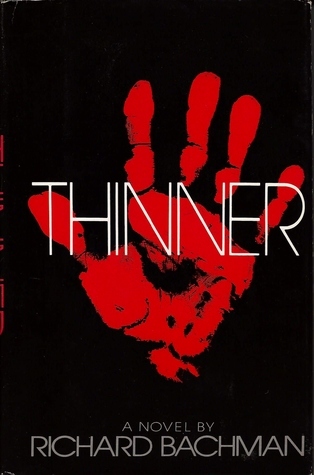in the realm where fiction bites as sharply as reality, Richard bachman’s Thinner offers a chilling exploration of guilt, fate, and the human body pushed to its breaking point. Shedding More Than Pounds: A Thoughtful Look at Richard Bachman’s Thinner steps beyond the surface of this dark tale, inviting readers to reconsider the novel’s haunting narrative through a fresh, contemplative lens. This review delves into the layers of horror and humanity entwined within Bachman’s work, tracing how Thinner balances thrills with thoughtful provocations about justice and self-destruction.
Exploring the intricate blend of horror and psychological suspense in Richard Bachman’s Thinner that captivates readers throughout the story
Richard Bachman, the pseudonym behind Stephen King’s alter ego, masterfully weaves a narrative that does not merely scare but profoundly unsettles. In Thinner, the horror is not unleashed through supernatural chaos alone but is deeply rooted in the psychological unraveling of its protagonist, Billy Halleck. The gradual physical change becomes a metaphor for guilt and retribution,compelling readers to grapple with the moral consequences that lurk beneath the surface of a seemingly straightforward curse. This blend of visceral dread and inner turmoil ensures that fear is not just something to witness, but something to feel crawling beneath the skin.
What makes the story resonate so powerfully is Bachman’s precise manipulation of tension, balancing the external horror elements with the internal collapse of sanity. The narrative builds around several key elements that heighten its gripping nature:
- Character complexity: Billy’s conflicting emotions and denial create empathy and dread together.
- Atmospheric dread: The slow deterioration of Billy’s body and mind mirrors the encroaching darkness enveloping his world.
- Inevitable retribution: The inescapable nature of the curse questions justice and fate.
Together, these facets craft a story experiance that is as intellectually provocative as it is emotionally harrowing.
| Element | Impact |
|---|---|
| Body Transformation | Physical terror symbolizing inner guilt |
| Judicial Corruption | Undercuts faith in legal justice |
| Supernatural curse | Forces confrontation with fate |
Analyzing the vivid portrayal of curses and consequences as central themes driving the narrative momentum and character development

The novel’s use of curses functions not merely as a supernatural plot device but as a profound metaphor for the inescapable consequences of one’s actions. Richard Bachman intricately weaves a narrative where the protagonist’s ordeal with the curse becomes a relentless descent into personal accountability and existential dread. The curse is vivid and visceral,compelling the reader to confront the dual nature of justice-both immediate and long-lasting. As the weight of the curse grows heavier,so too does the protagonist’s internal struggle,fostering a darkly compelling dialog between fate and free will.
Character development is intimately tied to the unfolding consequences, creating a dynamic interplay that propels the story forward. The physical transformation, marked by the relentless loss of pounds, is a tangible portrayal of eroding control and mounting desperation. Within this framework,several themes emerge:
- Loss of identity: As the body changes,the self begins to unravel.
- Moral reckoning: Actions once dismissed come crashing back with unforgiving clarity.
- Isolation and alienation: The curse pushes the protagonist away from loved ones and society.
These elements combined push the narrative momentum, making the story not only about fear of the supernatural but also a profound exploration of human vulnerability and the burdens of guilt.
| Theme | Manifestation | Impact on character |
|---|---|---|
| Curse | Uncontrollable weight loss | Heightened anxiety and desperation |
| Consequence | Strained relationships | Isolation and self-reflection |
| Accountability | Moral dilemmas | Internal conflict and growth |
Unpacking the main character’s gradual physical transformation and its symbolic reflection of guilt and retribution in the novel

as the protagonist’s body wastes away, the physical transformation becomes a visceral manifestation of his internal turmoil. Each pound lost is not just a number on a scale but a visible marker of mounting guilt and the inescapable weight of his past actions. His shrinking form becomes a living testament to retribution,where the cursed ”thinner” condition strips away more than flesh – it erodes pride,security,and ultimately his very identity. The progression is neither sudden nor discreet; it is torturously gradual, mirroring how guilt seeps invisibly but persistently, consuming his sense of self with every agonizing drop in weight.
Symbolic elements woven into this transformation include:
- Loss of control: Physical decay parallels his diminishing command over life events.
- Isolation: His changing body alienates him from society, representing guilt’s social consequences.
- Inevitable decay: The unstoppable weight loss hints at the soul’s erosion under the burden of retribution.
| Stage | Physical Signs | Symbolic Meaning |
|---|---|---|
| Early | Subtle weight loss, pallor | Emerging conscience, initial guilt |
| Middle | Visible frailty, weakened posture | Growing remorse, loss of dignity |
| Late | Severe emaciation, near collapse | Complete surrender to punishment, identity dissolution |
Examining how Bachman’s concise yet immersive writing style enhances the eerie atmosphere and deepens reader engagement

Richard Bachman’s narrative approach in Thinner is a masterclass in brevity fused with vivid detail,a combination that intensifies the book’s chilling ambiance. His sentences rarely meander; instead, they slice through the narrative with precision, creating a rhythm that mirrors the inexorable acceleration of the protagonist’s descent. This economy of words allows the eeriness to seep through subtly, embedding itself in the reader’s mind without overwhelming exposition. The minimalist style invites readers to fill the gaps, making their imaginations active participants in conjuring the horror, which in turn deepens their emotional investment.
- Sharp, evocative imagery: Crisp descriptions that invoke sensory unease.
- Unvarnished narrative pace: Fast-moving plots that maintain suspense.
- Subtle psychological cues: Implied fears that build tension beneath the surface.
Moreover, Bachman’s style acts as a bridge between character and reader, pulling us toward an intimate understanding of the protagonist’s plight without reliance on heavy-handed drama. The brevity fosters a dogged immediacy that feels almost claustrophobic, placing the reader inside the suffocating weight of the curse. Through this immersive microcosm, we are not merely observers but unwilling conspirators in the unraveling tragedy. This method enriches engagement, as each pared-down line carries more emotional weight and significance than a paragraph of flowery prose might, leaving a lasting imprint on the psyche.
Highlighting the cultural and societal critiques subtly woven into the plot through the protagonist’s unraveling life and isolation
Beyond the eerie premise of a curse-induced rapid weight loss, Thinner probes the corrosive undercurrents of society through the protagonist’s descent into isolation. Billy Halleck’s unraveling is not just physical but symbolic, mirroring the alienation faced by individuals caught in the unforgiving gears of societal judgment and legal injustice. His growing detachment from family and friends reflects a broader commentary on how communities can turn indifferent or even hostile when confronted with misfortune or deviation from norms. The curse acts as a metaphor for the invisible penalties exacted by societal systems-be it discrimination, guilt, or loss of control-that consume a person quietly, relentlessly.
Embedded within the narrative are subtle critiques of power dynamics and the fragility of status.Billy’s initial arrogance and reliance on his lawyerly influence expose the flaws in a justice system often skewed by privilege.As his life spirals, the veneer of control erodes, unveiling the precariousness of societal positions. This decay is eloquently underscored by moments that highlight:
- The illusion of control: Billy believes he can manipulate outcomes until the curse strips this away.
- Societal hypocrisy: The community’s willingness to ostracize and judge contrasts with their initial respect.
- Isolation as consequence: Emotional and physical seclusion magnified by his deteriorating condition.
| aspect | Symbolism in Thinner | Broader Commentary |
|---|---|---|
| Weight Loss | Physical manifestation of curse | Loss of identity and societal stripping |
| Legal System | billy’s initial immunity | Privilege masked as justice |
| Isolation | Withdrawal from loved ones | Emotional fallout from social alienation |
Discussing the balance of supernatural elements and grounded human fears that make Thinner a unique entry in the horror genre
Thinner masterfully intertwines supernatural horror with the raw, unsettling reality of human vulnerability, creating a narrative that feels both otherworldly and painfully relatable. The novel’s curse-a mysterious, unstoppable weight loss stemming from a mystical judgment-serves as more than just a fantastical plot device. It reflects deeper societal anxieties about bodily autonomy, mortality, and the fear of gradual decay. By anchoring the supernatural affliction in familiar fears, Bachman blurs the line between myth and reality, inviting readers to confront what it means to lose control over one’s own body and fate.
This balance is further enriched through the story’s focus on personal guilt and retribution. While the curse is supernatural, its trigger is grounded in human fallibility-an act of injustice that unleashes an ancient vengeance. Such layering turns the horror into a mirror of real-world consequences,where internal fears manifest as external horrors. Consider the table below to visualize this delicate balance:
| aspect | Supernatural Element | Human Fear |
|---|---|---|
| Causal Force | Ancient curse | Guilt and accountability |
| Effect | Uncontrollable weight loss | Loss of health and identity |
| Resolution | Breaking the curse | Facing one’s own moral failings |
- Supernatural dread propels the plot,making fear tangible.
- Human psychology grounds the horror in emotions everyone understands.
- Symbolism turns the curse into an exploration of societal and personal consequences.
By weaving these threads, Thinner stands out in the horror genre-not just as a tale of a mystical punishment, but as a profound commentary on how our deepest fears can take shape in the most visceral, horrifying ways.
Reviewing the pacing and plot structure that maintain tension without overwhelming or confusing the reader
Richard bachman, the pseudonym under which Stephen King penned Thinner, expertly balances a steady build-up of suspense with moments of chilling clarity that prevent readers from becoming lost in the unfolding nightmare. The novel unfolds at a purposeful pace, allowing characters and situations to develop organically. Key events are spaced out just enough to keep curiosity peaked, without overwhelming the audience with rapid-fire twists. This measured rhythm creates a suffocating tension that’s more psychological than frantic, luring readers deeper into the story’s macabre spiral while maintaining a clear sense of direction.
the plot structure itself is tightly woven yet accessible,guiding the reader through layers of despair and moral complexity. Bachman employs a clever mix of cause-and-effect sequences alongside subtle foreshadowing, which not only maintain intrigue but also subtly hint at the inexorable fate awaiting the protagonist. Elements such as:
- incremental stakes escalation that mirror the mounting horror
- Intermittent flashbacks revealing past transgressions
- Consistent character motivations that ground the narrative
all contribute to a tension that simmers beneath the surface, rather than erupting too suddenly. This careful pacing ensures readers remain engaged and emotionally committed, avoiding both the trap of confusion and the exhaustion of relentless action.
Considering the implications of justice and fate as presented through the novel’s moral dilemmas and ambiguous resolutions
At the heart of Thinner lies a labyrinth of moral ambiguities where justice intertwines with an almost inevitable fate. The curse imposed on Billy not only serves as a physical punishment but also functions as an allegory for the consequences of unchecked hubris and moral failure. Rather of straightforward retribution, the novel presents justice as a relentless, consuming force that defies easy categorization-prompting readers to question whether punishment truly fits the crime or if it’s merely fate’s cruel design at play. The blurred lines between victim and perpetrator challenge traditional notions of right and wrong, urging us to confront the complexities enveloped in every moral decision.
- Justice is portrayed as subjective and multifaceted, far from absolute or equitable.
- Fate operates as an unstoppable undercurrent, suggesting inevitability rather than free will.
- Moral dilemmas arise as characters grapple with guilt, obligation, and survival.
- Ambiguous endings resist closure, inviting ongoing reflection and debate.
| Aspect | Representation | Effect |
|---|---|---|
| Justice | Unpredictable and personal | Uncertainty breeds tension |
| Fate | Inescapable curse | Sense of dread and inevitability |
| Moral Choices | Shades of gray | Deepens character complexity |
This intricate web of justice and fate forces readers to dwell on the lingering questions rather than neat resolutions. Richard Bachman doesn’t just tell a story about punishment; he crafts a meditation on the fragility of human ethics when confronted by forces beyond control. The unresolved tensions in Thinner ensure that notions of fairness and destiny remain not definitive verdicts but rather ongoing dilemmas,reflecting the messy,unpredictable nature of real life itself.
Insights into how the setting amplifies the themes of alienation and inevitability, adding layers to the psychological horror
In Thinner, the oppressive atmosphere of the rural setting acts as a mirror reflecting the protagonist’s growing isolation. The small-town backdrop-with its winding roads,shadowy woods,and insular community-heightens the feeling of entrapment,both physically and psychologically. As the curse tightens its grip, the landscape’s claustrophobic vibe contrasts sharply with the vast, unyielding nature that surrounds it, highlighting a profound sense of alienation. Here, nature is not a sanctuary but a relentless force that underscores the protagonist’s diminishing control and impending doom.
The interplay between setting and theme is further enriched through the deliberate use of isolation in various contexts:
- Confined Social spaces: The protagonist’s alienation is amplified by limited social interactions, where whispers and side glances serve as constant reminders of his ostracism.
- Unchanging Habitat: The unrelenting scenery emphasizes the inevitability of fate,suggesting that no matter how much one struggles,escape is an illusion.
- Symbolic Natural Elements: The decaying trees and barren fields metaphorically parallel the protagonist’s physical and mental decline.
| element | Symbolic function | effect on Theme |
|---|---|---|
| Rural Isolation | Encapsulates loneliness | Amplifies alienation |
| Endless Roads | Represents inescapability | Highlights inevitability |
| Shadowy Hills | Creates foreboding atmosphere | Deepens psychological horror |
Recommendations for readers who appreciate character-driven thrillers with a blend of suspense and supernatural intrigue
If you find yourself captivated by narratives where meticulous character development drives the tension and mystery forward, Richard Bachman’s Thinner offers a compelling blend of personal transformation and creeping dread. The story masterfully delves into the psyche of its protagonist, whose encounter with a supernatural curse becomes a dark mirror reflecting his deepest vulnerabilities and flaws.This nuanced interplay between internal turmoil and external menace creates a rich tapestry that will resonate with readers who crave thrillers that engage both the mind and the senses.
For those eager to explore similar works, consider titles that balance psychological complexity with otherworldly elements, enhancing the suspense with layers of eerie ambiguity. Below are a few recommendations that echo Bachman’s style:
- Joe Hill’s Heart-Shaped Box - a chilling exploration of obsession and hauntings with deeply flawed characters.
- Shirley Jackson’s The Haunting of Hill House – atmospheric horror rooted in the fragile human psyche.
- Mark Danielewski’s House of Leaves – a labyrinthine narrative blending suspense with supernatural mystery.
- Stephen King’s The Shining – a layered character study set against a backdrop of paranormal terror.
| Title | Focus | Why It Resonates |
|---|---|---|
| Heart-Shaped Box | Obsession & Haunting | Dark emotional depth & ghostly suspense |
| The Haunting of Hill House | Psychological horror | Character fragility amidst eerie setting |
| House of Leaves | Meta-Thriller | Labyrinthine mystery & unreliable narration |
| The Shining | Supernatural & Madness | Psychological descent meets paranormal |
Comparing Thinner to other works by Richard Bachman and Stephen King to understand thematic and stylistic continuities
Thinner stands as an intriguing bridge between Richard Bachman’s raw narrative approach and the hallmarks of Stephen King’s broader oeuvre. While Bachman frequently enough leans into grittier, more unfiltered storytelling, this novel retains the haunting psychological depth familiar to King fans. Themes of guilt, revenge, and supernatural punishment weave through Thinner much like they do in King’s Carrie or The Shining, but Bachman’s work strips away some of the ornate horror in favor of a relentless, almost clinical descent into despair. The exploration of personal downfall through a seemingly simple premise-a curse manifesting as uncontrollable weight loss-reflects a thematic continuity in the examination of inner demons externalized in horrific ways.
Stylistically,Thinner adopts a leaner prose style characteristic of Bachman’s novels,prioritizing pace and tension over the detailed world-building that typifies much of King’s work.This distinction creates a unique reading experience marked by urgency and stripped-away complexity,yet it preserves King’s knack for character-driven horror. The following comparison illustrates key elements where Thinner intersects with and diverges from other works by both pen names:
| Aspect | Thinner (Bachman) | Stephen King’s Works |
|---|---|---|
| Theme | Supernatural justice, relentless guilt | Good vs. evil, psychological horror, redemption |
| Style | Concise, direct, fast-paced | Detailed, atmospheric, character-rich |
| Tone | Dark, urgent, fatalistic | Varying (from eerie to contemplative) |
| Protagonist | Flawed, desperate everyman | Diverse, complex range of archetypes |
- Shared motifs: curses, moral ambiguity, and the disintegration of normalcy under supernatural strain.
- Different approaches: Bachman as the minimalist counterpoint to King’s immersive storytelling style.
- Emotional impact: Bachman’s raw urgency versus King’s layered emotional resonance.
What makes Richard Bachman’s narrative voice distinct and the influence of his alter ego on shaping the book’s tone and message
Richard Bachman’s narrative voice in Thinner inhabits a space of stark realism infused with an unsettling undercurrent, allowing readers to traverse the terrifying descent of its protagonist with a chilling intimacy. Bachman’s prose is deceptively simple yet razor-sharp, marked by a pragmatic rhythm that mirrors the relentless progression of the curse itself. This grounded storytelling style strips away unnecessary embellishments, which amplifies the novel’s eerie tone-transforming ordinary circumstances into harbingers of dread. The voice quietly compels readers to confront themes of guilt, justice, and inevitability without the distraction of overt melodrama, fostering a sense of suffocating claustrophobia as the narrative unfolds.
The alter ego of Stephen King,Richard Bachman,serves as more than a nom de plume; he injects a distinctive,grittier sensibility that profoundly shapes the book’s mood and message.This duality allows for a sharper exploration of the human condition under pressure, where moral ambiguity thrives and existential anxieties surface. key features of Bachman’s influence include:
- Unflinching moral complexity: Characters exhibit flaws and contradictions without clear redemption arcs.
- Minimalist yet evocative language: the narrative’s lean style underscores the inevitability of fate.
- Subtle social commentary: Underlying critiques of justice and societal decay permeate the story.
| Aspect | Stephen King | Richard Bachman |
|---|---|---|
| Voice Tone | Expressive, Sprawling | Concise, Clinical |
| Thematic Focus | Supernatural vs. Human | Psychological Decay |
| characterization | Sympathetic, Complex | Flawed, Ambiguous |
By channeling the Bachman persona, the novel inhabits a rawer psychological territory, inviting readers to weigh uncomfortable questions about accountability and transformation. This voice acts as a mirror, reflecting the darker shades of human nature, and in doing so, elevates Thinner beyond simple horror into a meditation on the inexorable consequences of one’s actions.
Thinner offers more than just a journey through horror and suspense-it invites readers to ponder the weight of guilt, fate, and retribution. Richard Bachman’s (Stephen King’s) tale strips away the superficial to reveal the vulnerable, frequently enough unsettling truths beneath. Whether your drawn by the chilling narrative or the deeper moral questions it raises, Thinner leaves a lasting impression that lingers long after the final page. This thoughtful exploration reminds us that sometimes, what we shed is more than just pounds-it’s a piece of our very humanity.









